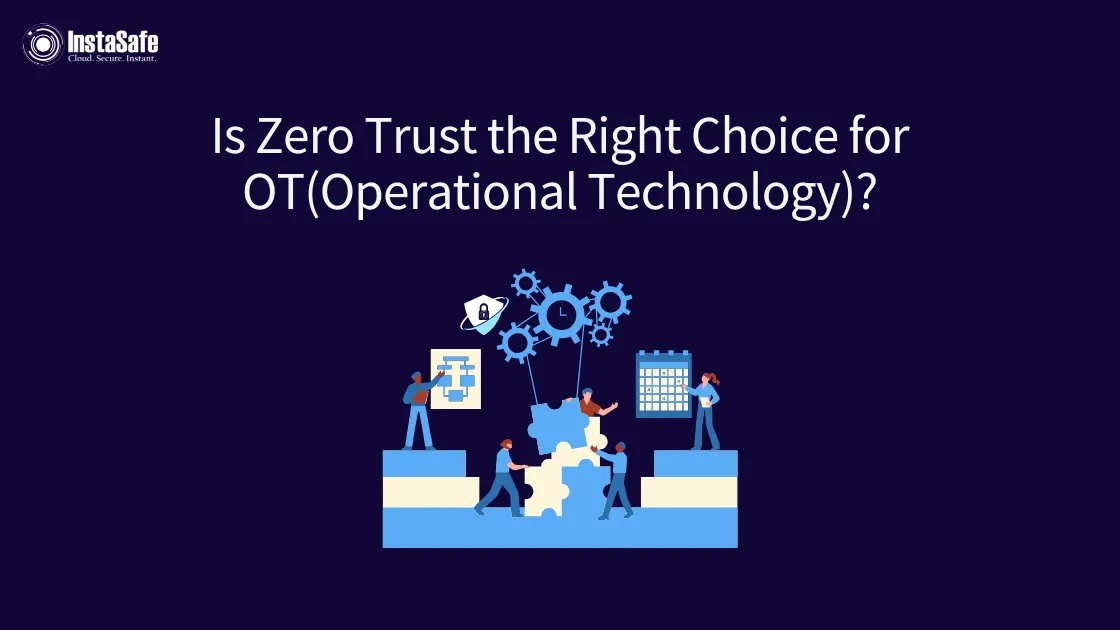Is Zero Trust the Right Choice for OT(Operational Technology)?

Organisations with operational technology environments like factories and critical infrastructure are undergoing a significant transformation. Traditionally, these systems were isolated from regular business networks through "air-gapping," but this separation is rapidly disappearing.
The convergence of information technology (IT) networks and operational technology is taking place to fulfil the needs of businesses, provide support for digital initiatives and allow remote work capabilities.
While connecting these systems brings benefits like enhanced production through data sharing and access to cloud-based tools, it also creates new security challenges.
This merging of networks provides easier access for bad actors to reach previously isolated OT security environments, exposing vulnerabilities and increasing both security and production risks.
Understanding Operational Technology
Operational technology refers to the systems that control and monitor physical processes and equipment in industrial environments.
These include sensors, monitors, actuators, industrial robots, programmable logic controllers (PLCs) and other technologies that form part of the Industrial Internet of Things (IIoT). Unlike IT systems designed for various applications, operational technology systems are purpose-built to automate specific industrial processes.
The key difference between IT and OT security lies in their objectives. While IT security focuses on protecting data, operational technology security aims to protect physical processes. Attackers targeting OT systems are trying to cause real-world disruption by manipulating or damaging physical equipment like sensors, pumps, robots or vehicles.
The Challenges With Traditional Systems
One of the biggest hurdles in implementing zero trust for OT is the prevalence of legacy technology. Many operational technology environments include equipment deployed decades ago, long before cybersecurity was a consideration. Some machines were designed for 20-30 years of operation and cannot be easily updated or replaced.
Unlike IT systems with typical lifespans of 4-6 years, OT systems can remain in service for decades. This means OT security measures must account for infrastructure that may be out of date and possibly impossible to patch. Additionally, many OT components don't support the technologies or protocols required for modern security implementations.
What is Zero Trust Architecture?
Zero trust architecture shifts the security mindset from an implied trust model to an assumed breach state. Rather than automatically granting access based on network location, zero trust for OT evaluates trust on a per-transaction basis. Access is granted to verified users and devices based on contextual factors surrounding the request, with frequent re-verification.
There are two main approaches to implementing zero-trust architecture:
- Zero Trust Access (ZTA): Focuses on identifying and monitoring which users and devices are accessing the network.
- Zero Trust Network Access (ZTNA): Concentrates on application access, requiring users and devices to prove their credentials before accessing applications.
Key Considerations for Zero Trust in OT
Beyond Visibility
While mapping assets and monitoring network activity is important, effective OT security requires stronger measures to detect and actively block malicious activity. Passive visibility tools alone often create more problems than they solve, generating excessive alerts without improving security.
Inherent Security Limitations
Unlike IT systems, operational technology assets were not designed with security in mind. The ultimate OT targets are often the lowest-powered, least sophisticated devices on the network. These systems typically can not support basic security functions like user authentication or malware scanning.
This reality means that organisations need to implement additional technology to act as a security proxy for these vulnerable assets and perform security functions the assets themselves cannot handle.
Different Security Priorities
While IT security primarily protects data, operational technology security must protect physical processes. This fundamental difference requires tailoring zero trust for OT strategies to the unique realities of industrial environments.
Some zero-trust architecture approaches, like network segmentation, work well in both IT and OT, but others may only be applicable in certain parts of the OT network. OT security strategies must also monitor for anomalies in physical processes that might indicate a compromise.
Identity vs Behavior
In IT environments, user identity is the primary factor in security decisions. However, in operational technology environments, especially at lower network levels, the concept of user identity often disappears. PLCs don't check which user entered a command, and the human-machine interfaces might not track this information either.
Instead of focusing on identity, zero trust for OT policies needs to evaluate whether network traffic matches "known good" patterns and makes sense in the current environment. This includes factors like device location, timing of connections, role in the process and appropriate protocols.
Gradual Implementation
Implementing a comprehensive zero-trust architecture in OT environments is a journey, not an overnight transformation. Most organisations start with asset discovery and passive monitoring, then progress to patch management and network segmentation.
As they develop a clearer picture of normal operations, they can begin restricting unexpected connections, unnecessary traffic and potentially malicious commands.
Future Potential
With proper implementation, operational technology environments may eventually achieve more comprehensive security than IT networks.
This is because OT systems operate in more predictable, defined ways. In a fully mature zero trust for OT environment, every connection can be authenticated and authorised, every command can be validated, and only "known good" traffic is permitted.
While retrofitting existing facilities with zero trust architecture may be challenging, new facilities can be designed with these principles from the start.
Conclusion
Despite rising cyber threats, implementing zero-trust architecture in industrial environments requires a focused approach. By embracing these principles, organisations can strengthen their operational technology security while maintaining the reliability essential for industrial operations.
Our Zero Trust Network Access protects your operational technology without disrupting vital systems. It secures legacy equipment and critical infrastructure by verifying every connection. Prevent unauthorised access and enable safe remote work with InstaSafe — all while maintaining the reliability essential for industrial operations.
Frequently Asked Questions (FAQs)
- What are the initial steps to implement Zero Trust Architecture in an OT environment?
Start with comprehensive asset inventory, establish baseline behaviour patterns, implement network segmentation, and deploy continuous monitoring solutions. OT security requires gradual implementation of zero trust principles while maintaining operational continuity.
- How does Zero Trust Architecture impact performance in time-sensitive OT environments?
Zero trust architecture can introduce minimal latency in operational technology environments. Proper implementation prioritises critical control systems with optimised verification protocols, ensuring operational technology security without compromising performance-sensitive industrial processes.
- What specific compliance requirements should be considered when implementing Zero Trust in OT?
Operational technology security must align with industry-specific regulations like NERC CIP and IEC. Zero trust architecture implementation should incorporate compliance documentation, regular audits, and security controls specific to OT regulatory frameworks.
